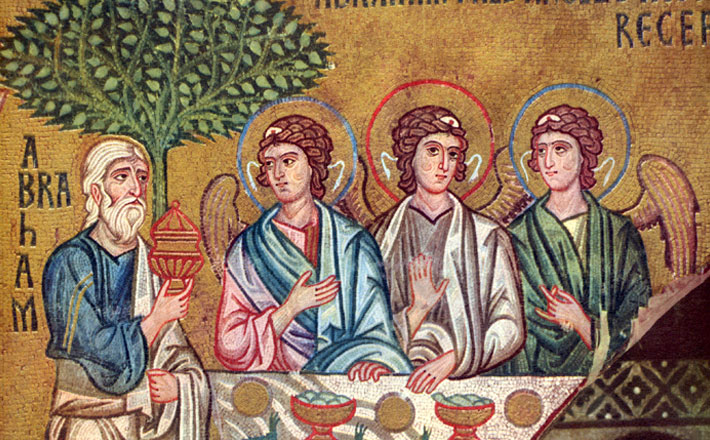Commentary on Colossians 1:15-28
One of the goals this pseudonymous author has in writing this letter is to reassure its recipients that they already dwell securely in the reality that is Jesus Christ.
To enhance their understanding of what this entails, the author presents what has come to be called a Christ hymn (1:15-20), which most likely had been in liturgical use prior to its inclusion into this letter. The material draws upon Jewish Hellenistic wisdom tradition in which Wisdom was regarding as the divine agent for creation (Proverbs 8:27-31; Sirach 24:5-6) and its unity (Wisdom of Solomon 1:6-7; Sirach 43:26).
The first part of the hymn (1:15-17) presents Christ’s role in and for creation. As the image of God, Christ manifests the presence of the transcendent God within creation (1:15a). Christ’s supreme rank within creation is highlighted by presenting him as the firstborn of all creation (1:15b). This followed with the declaration that Christ is the means through which all of creation comes into existence including everything (except God) in the heavenly realms and the earthly realms (1:16a). In addition to being the originating agent of all creation, Christ stands as the ultimate goal of creation (1:16b). In 1:17a the hymn declares that Christ is before creation (both in terms of time and rank) while in 1:17b Christ is presented as creation’s unifying and sustaining agent.
The second part of the hymn (1:18-20) moves to Christ’s salvific role and actions. The church is given high status within creation by virtue of being the body with Christ as its head while also implying that as body the church is under the control and direction of Christ (1:18a). Christ’s first-born status is reiterated in 1:18b, only now it is not of creation but of the dead so that Christ’s resurrection gives him even greater preeminence other everything.
In claiming that “all the fullness dwells in him” (note that the word “God” does not appear in the Greek of 1:19) Christ is the expression and embodiment of God’s own being. Finally and climactically Christ is the agent through whom God reconciled all things to God’s own self via the cross as the means by which God made peace with everything in heaven and upon earth. Thus through the event of the cross, God has restored an equilibrium to all created reality.
Cosmic reality as presented through the Christ hymn helps the letter’s recipients understand that they do not need to perform an array of ascetic practices or seek ecstatic visions either to appease cosmic powers who otherwise will vex them or to experience a fuller relationship with God as some false teachers have claimed. Christ has preeminence over all the powers of the cosmos and through his death everything in all creation including such powers have been reconciled to God. Thus through the hymn’s claims regarding the cosmic Christ, the author provides his audience with an assuredness in who and whose they are.
Indeed beginning 1:21 through the use of an emphatic “you” the author moves directly from the cosmic scale of Christ and his role in God’s salvific plan to the audience’s own experiences. He reminds them that they themselves had been at enmity with God expressed through their hostile disposition and evil conduct. Nevertheless, Christ established an entirely new reality for them as a result of his death in which they are not only reconciled and forgiven (recalling 1:14) but Christ has established them as holy (recalling 1:2), guiltless, and beyond reproach (1:22).
In 1:23 the author does present a caveat to the Christ-established reality in that they are to remain faithful and resolute rather than turning away from the hope of the gospel that they originally heard and which is the inclusive, universal proclamation of the author. The hope of the gospel (recalling 1:5, 12) is their eschatological destiny which the false teachings to which they have been recently been exposed are a threat.
While Paul most likely did not write this letter, the pseudonymous author now holds up Paul’s ministry and its attendant sufferings as having an important role in God’s salvific plan. The author presents Paul as a ministering servant of the gospel with a divine commission to fulfill God’s word by making it known (1:25). Through such a gospel ministry, God’s hidden plan is manifested so that Gentiles who had previously not been part of God’s people would be included among God’s holy people and would come to know that the richness of God’s hidden plan is Christ in them as the hope of glory (1:26-27).
Thus not only does the audience live in the realm or sphere of existence which is Christ (1:2, 4, 28) and are participants in Christ’s body, the church (1:18, 24), but Christ dwells in their lives, solidifying an intimate relationship with the one through whom and for whom all creation came into existence and continues to be sustained and ruled (1:15-17). This ministry also includes ongoing admonishment and instruction so that each and every believer would live a wise, holistic life in their relationship with Christ now and into the future (1:28).
While such a ministry includes toils and struggles it is also made possible by the fact that Christ — not Paul — is the energizing force behind this ministry (1:29). Finally, this ministry also involves suffering because forces (presumably human and non-human) are resistant to it. Nevertheless, there can be rejoicing in the midst of and through such suffering because he is “completing what is lacking in Christ’s afflictions for the sake of his body, that is, the church” (1:24 NRSV).
By this the author does not mean that Christ’s death was deficient or incomplete. Rather such gospel ministry suffering is a demonstration of the gospel’s lasting importance especially in the face of rejection and overt opposition to the gospel. Because this was most likely written subsequent to Paul’s death, these words of his ministry and his suffering would have been even more poignant to the recipients of this letter.


July 21, 2013